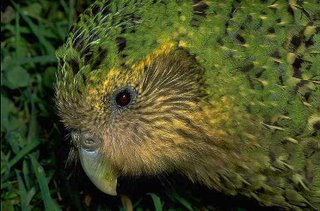 [The Kakapo] [www.kakapos.com]
[The Kakapo] [www.kakapos.com]As a bird watcher of somewhat questionable skill and dedication I have decided to begin a series grandly titled Birds of the World. In today's first instalment I proudly present The Kakapo. In subsequent episodes I promise to introduce you to birds I have actually had the pleasure of meeting, among them the Masked Booby, Red-whiskered Bulbul, and the backwards flying (yes! backwards flying!) Red-tailed Tropicbird.
I first met the Kakapo in the pages of Douglas Adams' Last Chance to See, a book that documented his travels around the globe to observe animals that were on the verge of extinction. Adams' writing betrayed a special sympathy for the Kakapo, a flightless bird incapable of adapting to accommodate the massive changes wrought to its environment:
"The kakapo is a bird out of time. If you look one in its large, round, greeny-brown face, it has a look of serenely innocent incomprehension that makes you want to hug it and tell it that everything will be all right, though you know that it probably will not be."
[Douglas Adams]
A native of New Zealand, the Kakapo is a ground dwelling parrot that is defenceless in the face of introduced predators like foxes, cats and rats, particularly given its tendency to freeze when disturbed or threatened. Consequently it is no longer found on the New Zealand mainland, and exists only on a couple of smaller islands: Maud, Whenia Hou, Hauturu, Stewart, Pearl and Te Kakahu o Tamatea.
Kakapos are green in colour with soft downy feathers. They have an owl-like face, a waddling gait, and emit a distinct musty smell. They can weigh up to 4 kilograms and live for long periods (possibly even up to 60 years). Kakapos only reach sexual maturity after 9 to 10 years and then only breed every 2 to 5 years depending on the availability of food supplies. Males attract females by heading to high ground and 'booming' at night, a low-pitched call that can be heard up to 5 kilometres away. Only 86 Kakapo exist in the world; the current population is supported by an ongoing recovery breeding programme.
Ironically, while the Kakapo continues to exist, Douglas Adams is now extinct.
For more information on the Kakapo, see:
Kakapo Recovery
ARKive
BIRDLIFE International
I first met the Kakapo in the pages of Douglas Adams' Last Chance to See, a book that documented his travels around the globe to observe animals that were on the verge of extinction. Adams' writing betrayed a special sympathy for the Kakapo, a flightless bird incapable of adapting to accommodate the massive changes wrought to its environment:
"The kakapo is a bird out of time. If you look one in its large, round, greeny-brown face, it has a look of serenely innocent incomprehension that makes you want to hug it and tell it that everything will be all right, though you know that it probably will not be."
[Douglas Adams]
A native of New Zealand, the Kakapo is a ground dwelling parrot that is defenceless in the face of introduced predators like foxes, cats and rats, particularly given its tendency to freeze when disturbed or threatened. Consequently it is no longer found on the New Zealand mainland, and exists only on a couple of smaller islands: Maud, Whenia Hou, Hauturu, Stewart, Pearl and Te Kakahu o Tamatea.
Kakapos are green in colour with soft downy feathers. They have an owl-like face, a waddling gait, and emit a distinct musty smell. They can weigh up to 4 kilograms and live for long periods (possibly even up to 60 years). Kakapos only reach sexual maturity after 9 to 10 years and then only breed every 2 to 5 years depending on the availability of food supplies. Males attract females by heading to high ground and 'booming' at night, a low-pitched call that can be heard up to 5 kilometres away. Only 86 Kakapo exist in the world; the current population is supported by an ongoing recovery breeding programme.
Ironically, while the Kakapo continues to exist, Douglas Adams is now extinct.
For more information on the Kakapo, see:
Kakapo Recovery
ARKive
BIRDLIFE International
3 comments:
What a brilliant book! Last Chance to See was another book that made me cry.
Yes yes! Thank you. Meredith sent the questions on to me and I was trying to think of what books made me cry.
Fortunatly many of the species Adams' wrote about are still with us. I'm not sure about the Yangtze Dolphins though.
Apologies for the misplaced apostrophe above.
Post a Comment